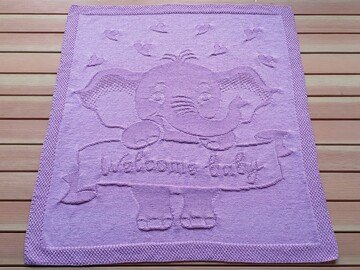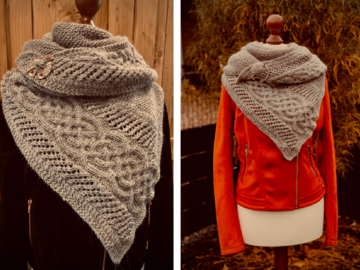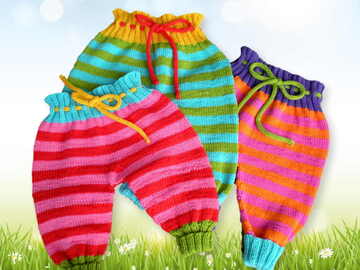.jpg)
This square with a letter is a nice and easy project to practice the double sided knitting technique. Luckily, the alphabet starts with an easy letter, as the “A” looks the same from the front as from behind, so the letter will show correctly on both sides. For other letters it’s not as easy, there you need to work the two sides a bit differently. But this is something I will show you in another blog entry. Now it’s time to concentrate on the «A».
If you are an experienced double knitter, you can skip the general information and scroll down to the section “Letter A”. Otherwise I recommend to read the instructions first before you start.
General information
Material used:
- You can use any yarn that is suitable for your procect; e.g. Schachenmayr Catania 100 % cotton (125 m / 50 gr), two different colours (one light, one dark); approx. 10 gr each (of course you can use any other / similar yarn)
- Circular needles 2.5 mm
- Additional circular needle 2.5 mm (alternatively 2.0 mm or 3.0 mm) for bind off
- Darning needle, scissors
Gauge (double knitted with both colours):
22 sts x 34 rows = 10 x 10 cm
Size of the finished coaster is approx. 10,5 cm x 10,5 cm
Please note: If you have a different gauge, the size of the finished product will be different, too.
Tipp for correction of stitches knitted with the wrong colorur:
If you should discover that you used the wrong colour for a stitch, you can either knit backwards. Or you can drop the stitch carefully up to the row where the wrong colour was used. Then you «knit» the stitch with the correct colour row by row with the help of a crochet hook. Repeat this for the second stitch of the concerned pair.
Cast on:
Cast on 24 pairs of stitches (one pair of stitches = 1 knit in colour 1, 1 purl in colour 2) with the invisible cast on (if you are not sure how to do this, you will find helpful video tutorials on the internet). If you cast on rather loosely, I recommend to use the smaller circular needle 2.0 mm, only for cast on.
Of course, you can use any other cast on method suitable for double knitting that you are familiar with.
Please note: so that the instructions below will be correct for your work, in row 1, main colour must be your dark colour, and contrast colour must be your light colour. If you use the invisible cast on, begin with your light colour, so after turning you will knit with the dark colour and purl with the light colour.
Row 1:
Now switch to the circular needles 2.5 mm, if you used the smaller ones for cast on.
Knit into back all (dark) knits, purl normally all (light) purls.
Cross threads when working the first pair of stitches and the last pair of stitches, thus the two sides will be connected at the edges.
Row 2 – Selvedge stitch:
Work all knits in your light colour, all purls in your dark colour.
Do a nice selvedge stitch from row 2 on, always at the end of the row. It looks nice and it binds both sides together.
Last knit stitch (light colour): slip stitch purlwise, yarn back (both colours)
.jpg)
Last purl stitch (dark colour): slip stitch purlwise, yarn back (light colour) respectively yarn forward (dark colour)
.jpg)
Turn; the light colour is front, the dark colour is back.
.jpg)
Knit and purl as usual.
The letter “A”
Knitting chart for the motif:
As the letter „A“ is symmetric, it is, as mentioned before, quite easy for us – with the classic double knitting approach, the letter shows correctly on both sides. So there is only one version for the knitting chart.
Knitting chart classic double knitting:
.jpg)
Explanation (every cell = one pair of stitches):
White cell = knit in main colour, purl in contrast colour
Blue cell = knit in contrast colour, purl in main colour
Rows with odd numbers (1. and further): main colour = dark colour, contrast colour = light colour
Rows with even numbers (2. and further): main colour = light colour, contrast colour = dark colour
Tip: when double knitting in rows, main and contrast colour change with each row. Before you start each row, identify which is the main colour in this row and whether you work the chart from right to left or from left to right. For example, you can work all rows with odd numbers from right to left (in working direction), and all rows with even numbers from left to right (against working direction).
Detailed explanation
Rows 1-6
According to the knitting chart, the first six rows of the coaster „A“ are worked uni (i.e. knit in the respective main colour, purl in the respective contrast colour).
Row 7
As row 7 is a row with an odd number (with the dark colour as main colour), we work the knitting chart from right to left.
5 x k dark / p light
4 x k light / p dark
6 x k dark / p light
4 x k light / p dark
5 x k dark / p light (selvedge stitch at the end of the row)
Turn.
Row 8
The knitting chart is read from left to right, with yellow / light colour as main colour.
5 x k light / p dark
4 x k dark / p light
6 x k light / p dark
4 x k dark / p light
5 x k light / p dark (selvedge stitch at the end of the row)
Turn.
Row 9
The knitting chart is read from right to left, with grey / dark colour as main colour.
6 x k dark / p light
2 x k light / p dark
8 x k dark / p light
2 x k light / p dark
6 x k dark / p light (selvedge stitch at the end of the row)
Turn.
Continue the motif according to the knitting chart till row 36. In row 36 you don’t need to do a selvedge stitch, just knit and purl the last pair of stitches.
Now it’s time to bind off. As it fits perfectly with the invisible cast on, I will show you the invisible bind off here.
Invisible bind off:
Cut the light yarn. We continue binding off with the dark yarn. Cut the dark yarn and leave a strand in the length of approx 4 x the width of the coaster / pad (about 40-50 cm).
Separate the stitches in the front (all knit stitches) and back (all purl stitches) on two circular needles (you will need the additional circular needle now):
Take the first knit stitch from the left to the right tip of the current needle (1st needle). Take the first purl stitch on the additional needle (2nd needle). The next knit stitch again goes from the left to the right tip of the 1st needle, and the next purl stitch goes to the 2nd needle. And so on, until all stitches are separated:
.jpg)
Put the long dark strand into the darning needle.
Stick the darning needle purl wise into the 1st stitch on the 1st needle and pull through. The stitch stays on the needle.
Stick the darning needle knit wise into the 1st stitch on the 2nd needle and pull through. This stitch also stays on the needle.
*Stick the darning needle knit wise into the 1st stitch on the 1st needle. Drop this stitch off the needle. Stick the darning needle purl wise into the 2nd stitch on the 1st needle and pull through, this stitch stays on the needle.
Stick darning needle purl wise into the 1st stitch on the 2nd needle, drop this stitch off the needle. Stick darning needle knit wise into the 2nd stitch on the 2nd needle and pull through, this stitch stays on the needle.*
Repeat *-* across. Pull the yarn continuously, but not too tight, so that the bind off will be stretchable.
Weave in all ends. Done 😊
.jpg)
.jpg)
Hopefully you enjoyed doing this little project. Now you can use the motif resp. the knitting chart for various things, not only as a coaster or cleaning pad. I’m curious to hear about your ideas and creations. In addition to the «classic» ideas such as blankets (e.g. baby blanket with the baby’s name, or a sofa blanket with a saying) or pillow cases you could maybe try a head band with a name, or place mats with the names for all family members (the other letters will follow). My daughter uses the letters for playing and is quite creative.
Maybe you would like to write in the comments about your ideas and projects, or you would like to show a picture of your creation in the Crazypatterns photo gallery?
If you liked this little project, feel free to visit my shop – there you will find many double sided knitting patterns. If you follow my shop, you will always be informed when there’s news 😊
Please feel free to ask questions either by direct message or as a comment here on the blog site.
Kind regards, Sonja





























































































































































